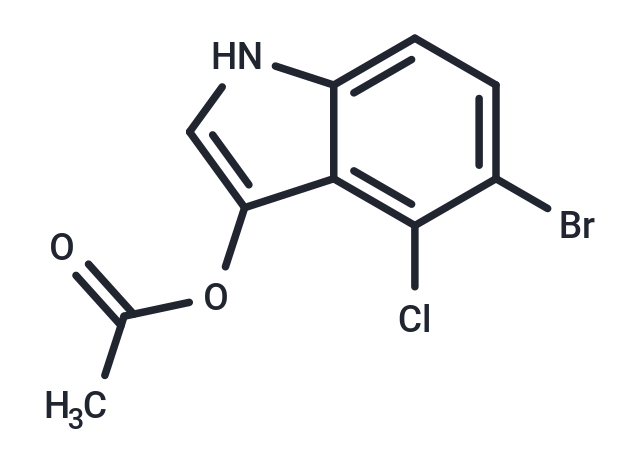Shopping Cart
Remove All Your shopping cart is currently empty
Your shopping cart is currently empty
BCDA (5-bromo-4-chloroindoxyl acetate) is a chromogenic substrate utilized to detect esterase activity.

| Pack Size | Price | USA Warehouse | Global Warehouse | Quantity |
|---|---|---|---|---|
| 10 mg | $30 | In Stock | In Stock | |
| 25 mg | $42 | In Stock | In Stock | |
| 50 mg | $61 | In Stock | In Stock | |
| 100 mg | $89 | In Stock | In Stock | |
| 500 mg | $238 | - | In Stock |
| Description | BCDA (5-bromo-4-chloroindoxyl acetate) is a chromogenic substrate utilized to detect esterase activity. |
| Cell Research | Instructions I. Reagent preparation 1. Mother solution preparation: Use an appropriate solvent (such as dimethyl sulfoxide (DMSO) or an organic solvent) to dissolve BCDA into a solution of a certain concentration. The concentration usually prepared is 0.1–1 mM. 2. Working solution preparation: Adjust the concentration of the solution according to the experimental requirements, and the common concentration range is 0.2 mM to 1 mM. The solution can be freshly prepared before the experiment. II. Operation steps 1. Sample preparation: The sample can be a solution containing esterase, cell or tissue extract. For cell or tissue samples, centrifugation or other treatment may be required to remove cell debris and obtain a clean sample suitable for esterase activity determination. 2. Reaction steps: 1) Substrate addition: Add a certain volume of BCDA solution to the sample, usually at a volume ratio of 1:1 to the esterase sample. 2) Reaction conditions: Incubate the reaction system at a suitable temperature (usually 37°C) for a certain time (usually 30–60 minutes). The specific incubation time can be optimized according to the experimental requirements. 3) Esterase catalytic reaction: Under the action of esterase, BCDA will be hydrolyzed to release bromine and chlorine products, usually obvious blue or green products, which can be detected by spectrophotometer. 3. Measurement: 1) Use a spectrophotometer to measure the absorbance (OD value) at a wavelength of 620 nm or 600 nm. The color product generated by esterase catalysis is positively correlated with the esterase activity. The higher the absorbance value, the stronger the esterase activity. 2) The esterase activity in the sample can be calculated based on the standard curve. 4. Data analysis: 1) The esterase activity is calculated by comparing the absorbance of the sample with the blank control. 2) The reaction kinetics of the esterase can be obtained by measuring the absorbance at multiple different time points. Notes: 1. Solubility: BCDA has poor solubility in water, so it is usually necessary to use organic solvents such as DMSO to prepare the solution. 2. Photosensitivity: BCDA is light-sensitive, so strong light exposure should be avoided during operation and storage to prevent substrate degradation. 3. Experimental conditions: Esterase activity may be affected by factors such as pH value and temperature, so the stability and consistency of experimental conditions should be ensured. |
| Synonyms | 5-bromo-4-chloroindoxyl acetate |
| Molecular Weight | 288.53 |
| Formula | C10H7BrClNO2 |
| Cas No. | 3252-36-6 |
| Smiles | CC(=O)Oc1c[nH]c2ccc(Br)c(Cl)c12 |
| Relative Density. | 1.721g/cm3 |
| Storage | keep away from direct sunlight | Powder: -20°C for 3 years | In solvent: -80°C for 1 year | Shipping with blue ice/Shipping at ambient temperature. | |||||||||||||||||||||||||||||||||||
| Solubility Information | Ethanol: 100 mg/mL (346.58 mM), Sonication is recommended. | |||||||||||||||||||||||||||||||||||
Solution Preparation Table | ||||||||||||||||||||||||||||||||||||
Ethanol
| ||||||||||||||||||||||||||||||||||||
| Size | Quantity | Unit Price | Amount | Operation |
|---|

Copyright © 2015-2026 TargetMol Chemicals Inc. All Rights Reserved.